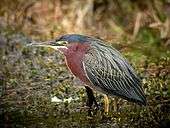Green-backed heron
"Green-backed heron" is a collective term for certain herons. Small and compact among herons, these birds often feature green plumage – rare among the Ardeidae –, in particular on the back, wings and scapulars.
They were formerly believed to make up a single species Butorides striatus, but are now treated as three largely allopatric species:
- Striated heron, Butorides striata – Widespread throughout the Old World tropics and in South America (Note that the grammatical gender of the specific name has been corrected from striatus)
- Lava heron, Butorides sundevalli – Endemic to the Galápagos Islands off Ecuador
- Green heron, Butorides virescens – Widespread from temperate North America south to Panama
These herons are tool-using animals. They are regularly seen picking up objects to use as a fishing lure, attracting prey fish.[1]
%2C_Santa_Cruz%2C_Galapagos.jpg) Striated heron on the Galápagos Islands
Striated heron on the Galápagos Islands_-fishing_on_Galapagos.jpg) Lava heron on the Galápagos Islands
Lava heron on the Galápagos Islands
Footnotes
- ↑ Norris (1975), Boswall (1983), Walsh et al. (1985), Robinson (1994)
References
- Boswall, J. (1983): Tool-using and related behavior in birds: more notes. Avicultural Magazine 89: 94-108.
- Norris, D. (1975): Green Heron (Butorides virescens) uses feather lure for fishing. American Birds 29: 652-654.
- Robinson, S.K. (1994): Use of bait and lures by Green-backed herons in Amazonian Peru. Wilson Bulletin 106(3): 569-571
- Walsh, J.F.; Grunewald, J. & Grunewald, B. (1985): Green-backed herons (Butorides striatus) possibly using a lure and using apparent bait. J. Ornithol. 126: 439-442.
External links
- Green heron fishing with lure on YouTube
This article is issued from
Wikipedia.
The text is licensed under Creative Commons - Attribution - Sharealike.
Additional terms may apply for the media files.